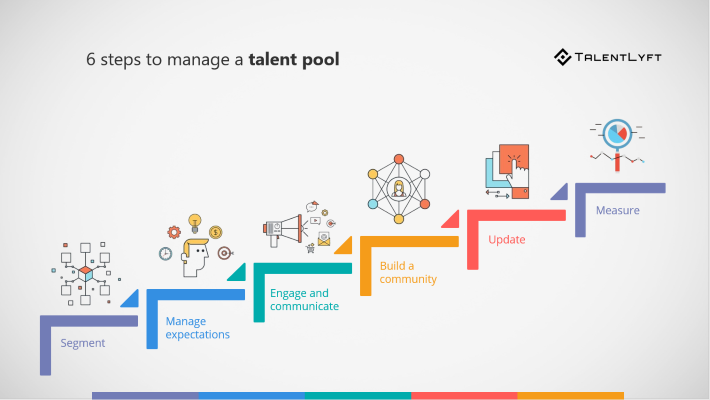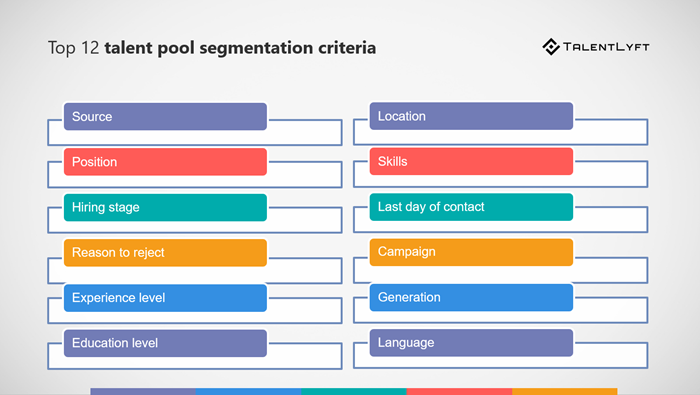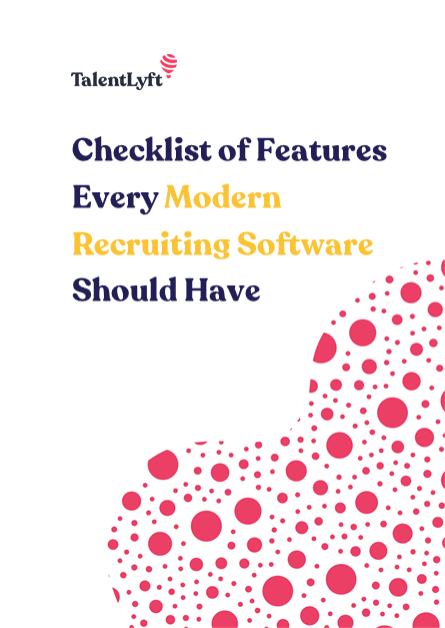![https://adoptostaging.blob.core.windows.net/article/0pOm3nwXhEm6SEPThfIO2Q.png?8619]()
What is talent pool segmentation?
Since you’re here looking to educate yourself on talent pool segmentation, I’ll assume you already know everything you need to know about talent pools and that you already have a talent pool (if you don’t, check out our article 13 Ways to Build Your Talent Pool).
In this blog post, we will explain in more details the first step of successful talent pool management process: talent pool segmentation.
Talent pool segmentation is the process of dividing your candidate database into smaller groups based on certain criteria.
For example, you can divide your candidate pool by the criteria of job position or a role. It means that you will group together candidates interested in different roles at your company, such as marketing, sales, IT, etc.
Why is it important to segment your talent pool?
As we already mentioned, talent pool segmentation is the first step of the successful talent pool management process.

Segmenting your talent pool is an extremely important step in talent pool management because it lays a foundation for all the following steps. If you don’t get the first step right and properly segment your talent pool, all your time and effort invested in the following 5 steps of talent pool management will go to waste.
To use your talent pool effectively and successfully, you need to segment it. The process of talent pool segmenting will help you understand who are the candidates in your talent pool. You’ll find out what your candidates have in common and how they are different from each other.
In other words, talent pool segmenting will enable you to get to know your candidates better. Consequently, you will be able to come up with the best ways to engage and attract them. By using the highly personalized and customized approach you will significantly improve the candidate experience.
Better candidate experience leads to higher candidate engagement. If you always have a pool of highly engaged candidates who are eager to work for your company, you will be able to fill your positions with better candidates faster, thus reducing your time and cost per hire while improving the quality of hire. These are just a few benefits of a proper talent pool segmentation.
Download Checklist of Most Important Hiring Metrics & Tips for Improvement!
Talent pool segmentation criteria
Now that you understand the importance and the benefits of talent pools segmentation, you are probably eager to start segmenting your own talent pool.
How should you segment your talent pool? What is the best way to do it? Which criteria should you use?
The general rule for segmenting your talent pool is to segment your talent pools based on your current and future hiring needs.
To get a clearer idea of the talent pool segmentation criteria that would work best for your company and its hiring needs, consult your talent acquisition plan, go through your candidate personas an evaluate your available resources.
You can segment your talent pool in a way to create wide groups (for example, students) or narrow your groups of candidates very specifically (for example, Yale computer science students). Advanced pool talent segmentation often involves combining a few different criteria.
To help you get started defining your own talent pool segmentation criteria, here is the list of the 12 most commonly used talent pool segmentation criteria:

Talent pool segmentation criteria #1: Source
By using a source as a talent pool segmentation criteria, you will divide the candidates form your database into 3 distinctive groups:
Sourced candidates
Applied candidates
Referred candidates.
Talent pool segmentation criteria #2: Location
Using a location as a talent pool segmentation criteria is especially useful if your company hires internationally or has a few offices or store locations in the same city. By using a location as a talent pool segmentation criteria, you can divide the candidates form your database into the distinctive groups by a continent, state, a city or a specific office or store location.
Talent pool segmentation criteria #3: Position
You can also divide your candidate pool by the criteria of their preferred job position or a role. It means that you will group together candidates interested in different roles at your company, such as marketing, sales, IT, etc.
Talent pool segmentation criteria #4: Skills
Another talent pool segmentation criteria you can use are skills. By using this segmentation criterion, you can divide candidates into different groups based on their different skills, such as communication, IT or managerial skills.
Talent pool segmentation criteria #5: Hiring stage
Hiring stage is a very common talent pool segmentation criteria. It is used to divide the candidates from your database into different groups based on the stage of your hiring process they are currently in.
Talent pool segmentation criteria #6: Last day of contact
Using last day of contact as your talent pool segmentation criteria is very important for keeping all the candidates in your talent pool engaged. Using this criteria will help you prevent falling out of touch with some great candidates.
Talent pool segmentation criteria #7: Reason to reject
Maintaining positive relationships with rejected candidates is very important for maintaining a strong employer brand. However, all rejected candidates are not the same - you’ll probably want to keep tighter relationship silver medalists than with candidates you rejected because you caught them lying in an interview.
Talent pool segmentation criteria #8: Campaign
Another especially useful way to segment your talent pool is by campaigns. Using this criteria will enable you to divide your candidates into different groups an create highly personalized campaigns for each of your groups.
Talent pool segmentation criteria #9: Experience level
By using an experience level as a talent pool segmentation criteria, you will divide the candidates form your database into 3 distinctive groups based on their professional experience:
Junior
Mid-level
Senior
Talent pool segmentation criteria #10: Generation
By using a generation as a talent pool segmentation criteria, you will divide the candidates form your database into 4 distinctive groups:
Baby Boomers
Generation X
Generation Y
Generation Z
Talent pool segmentation criteria #11: Education level
By using an educational level as your talent pool segmentation criteria, you will divide all the candidates from your talent pool into different groups based on their highest acquired educational level.
Talent pool segmentation criteria #12: Language
Finally, an extremely useful talent pool segmentation criterion is language. By using these criteria, you can localize and adjust your communication with the candidates from your talent pool.
Remember, the criteria we presented here are the most commonly used talent pool segmentation criteria. You don’t have to apply all of them - stick with the criteria that make the most sense for your company and its hiring needs.
Also, feel free to add any additional talent pool segmentation criteria you identify as relevant for your recruiting efforts. Don’t be afraid to experiment until you find the solution that works best for your company, its hiring needs and available resources.
Talent pool segmentation tools
Segmenting and managing your talent pool using Excel tables and email is an extremely dreadful and time-consuming process.
Luckily, modern all-in-one recruiting software such as our TalentLyft has a whole range of advanced features for building, segmenting and managing talent pools. TalentLyft also offers additional features to help you engage and nurture candidates in your talent pool.
To learn how using all-in-in recruitment software such as TalentLyft can help you build and maintain a more effective talent pool, schedule a free personalized demo with our experts. We will be happy to answer all your questions and offer helpful guidelines for creating and improving your talent pool. 🙂
Frequently asked questions
What is talent pool segmentation, and why is it important?
Talent pool segmentation is dividing your candidate database into smaller groups based on specific criteria, crucial for managing your talent pool effectively and understanding your candidates better.
What are some common criteria for segmenting a talent pool?
Common criteria include source (e.g., sourced, applied, referred), location, position, skills, hiring stage, last day of contact, reason to reject, campaign, experience level, generation, education level, and language.
How does segmenting a talent pool benefit recruitment efforts?
Segmenting a talent pool allows for personalized and customized engagement strategies, improving candidate experience, and engagement, and enabling faster, cost-effective hires of better quality.
What tools are recommended for talent pool segmentation and management?
Modern all-in-one recruiting software like TalentLyft is suggested, offering advanced features for building, segmenting, and managing talent pools efficiently.
What approach should be taken when segmenting a talent pool?
Segment your talent pool based on current and future hiring needs, considering your talent acquisition plan, candidate personas, and available resources. Feel free to experiment with different criteria until you find the best solution.


















